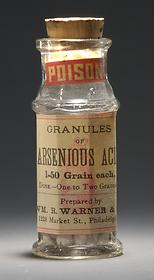Arsenic-based medicine, Wm. R. Warner & Co., about 1900
Arsenic was widely used as a medicine in the 19th and 20th centuries. The development of forensic toxicology coincided with the spread of mass-produced and commercially distributed medicines and poisons (sometimes the same thing), and an associated rise in murders and suicides involving those substances.
National Museum of American History, Behring Center, Smithsonian Institution
